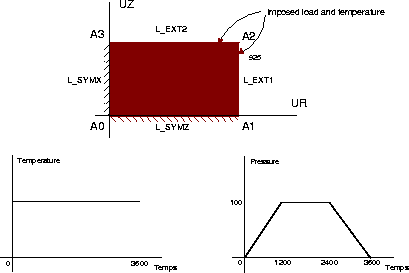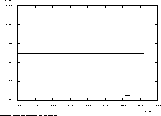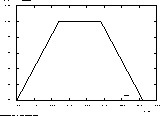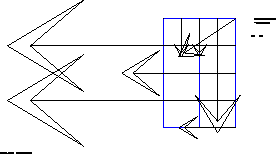
Test name
poudre1
Calculation type
POWDER COMPACTION - 2D MODE AXIS
Finite element type
QUA8
Topic
Viscoplastic model of Abouaf for consolidation of powders.
The structure is a cylinder consolidated by pressure load. The initial
density is assumed uniform, whereas the final density is obtained
with analytical calculation. The cylinder is also subjected to a field of
temperature. It follows a viscoplastic law according to the model
of Abouaf.
Goal
Test the model of Abouaf: poudre_A.
Version
97' customer version
Model description


Test poudre1 Results
RESULTS: Displacements for an isotropic densification

CASTEM FIGURES



complet = faux ;
*
*************************************************
* pour calcul complet mettre complet à : vrai;
***************************************************
*
************************************************************
* *
* Cas test pour la loi poudre_A *
* *
* par Christophe DELLIS (CEREM) *
* *
************************************************************
* cas isotrope
* un cylindre est densifié par mise en pression
* la densite initial est uniforme la densite finale
* est connue analytiquement
*
*opti echo 0 ;
*
option dime 2 elem qua8 mode axis ;
*
* parametres du maillage
*
rayon_1 = 10.0 ;
*
haute_1 = 15.0 ;
*
* definition des coordonnees des points
*
xa0 = 0.0 ;
ya0 = 0.0 ;
*
xa1 = rayon_1 ;
ya1 = ya0 ;
*
xa2 = xa1 ;
ya2 = ya1 + haute_1 ;
*
xa3 = 0.0 ;
ya3 = ya2 ;
*
* definition des densites
*
dena0 = 10.0 ;
dena1 = 10.0 ;
dena2 = 10.0 ;
dena3 = 10.0 ;
*
* definition des points
*
densite dena0 ;
a0 = xa0 ya0 ;
*
densite dena1 ;
a1 = xa1 ya1 ;
*
densite dena2 ;
a2 = xa2 ya2 ;
*
densite dena3 ;
a3 = xa3 ya3 ;
*
* definition des lignes
*
la0a1 = a0 droi 2 a1 ;
la1a2 = a1 droi 2 a2 ;
la2a3 = a2 droi 2 a3 ;
la3a0 = a3 droi 2 a0 ;
*
la3a2 = inve la2a3 ;
la2a1 = inve la1a2 ;
*
* lignes pour les conditions limites
*
l_symz = la0a1 ;
l_symx = la3a0 ;
l_ext1 = la1a2 ;
l_ext2 = la2a3 ;
*
* definition des surfaces
*
elmat1 = surf ( la0a1 et la1a2 et la2a3 et la3a0 ) plan ;
*
piece_1 = coul elmat1 bleu ;
*
tot = piece_1 ;
elim (tot et a2) 0.001 ;
*
*
************************************************************
* *
* calcul *
* *
************************************************************
*
T0TEMPE = 925.0 ;
T1TEMPE = 925.0 ;
T0TEMPS = 0.0 ;
T1TEMPS = 1200.0 ;
T2TEMPS = 2400.0 ;
T3TEMPS = 3600.0 ;
*
*******************************************
* Champ-point de temperature
*******************************************
*
clth0001 = BLOQ 'T' (l_ext1 et l_ext2) ;
p_bloth1 = DEPI clth0001 1. ;
p_temps1 = prog T0TEMPS T1TEMPS T2TEMPS T3TEMPS ;
p_theta1 = prog T0TEMPE T1TEMPE T1TEMPE T0TEMPE ;
ev_ther1 = EVOL MANU TEMPS p_temps1 'T' p_theta1 ;
ch_ther1 = CHAR TIMP p_bloth1 ev_ther1 ;
*
************************************************************
* *
* materiau *
* *
************************************************************
P1MODEL = MODE piece_1 MECANIQUE ELASTIQUE
VISCOPLASTIQUE POUDRE_A CONS DEUX;
*
V1YOUNG = 118.0E+03 ;
V1NU = 0.33 ;
V1ALPHA = 10.0E-10 ;
V1A = 7.76E-15 ;
V1N = 4.55 ;
V1QSRT = 0.0 ;
V1RHOR = 0.68 ;
V1F0 = 0.1098 ;
V1F1 = 1.0168 ;
V1F2 = -0.2591 ;
V1F3 = 0.0 ;
V1F4 = 0.0 ;
V1F5 = 0.66 ;
V1C0 = 2.10851 ;
V1C1 = 1.21767 ;
V1C2 = -0.43081 ;
V1C3 = 0.0 ;
V1C4 = 0.0 ;
V1C5 = 50.0 ;
*
P1MATER = MATER P1MODEL YOUNG V1YOUNG NU V1NU ALPHA V1ALPHA
A V1A N V1N QSRT V1QSRT F0 V1F0 F1 V1F1 F2 V1F2 F3 V1F3
F4 V1F4 F5 V1F5 C0 V1C0 C1 V1C1 C2 V1C2 C3 V1C3 C4 V1C4
C5 V1C5 RHOR V1RHOR ;
*
P2MODEL = MODE piece_1 THERMIQUE ISOTROPE CONS UN ;
*
P2MATER = MATER P2MODEL 'C' 460 'K' 14.6 'RHO' 4.54 ;
*
************************************************************
* *
* chargement *
* *
************************************************************
*
p0bloca = bloque uz l_symz ;
p1bloca = bloque ur l_symx ;
*
p_bloca = p0bloca et p1bloca ;
*
t0pres = 0.0 ;
t1pres = 100.0 ;
*
li_tps = prog t0temps t1temps t2temps t3temps ;
li_pres = prog t0pres t1pres t1pres t0pres ;
ev_pres = evol manu temps li_tps pression li_pres ;
*dess ev_pres titr 'Evolution du chargement en pression' nclk ;
*
p2force = pres mass p1model 1.0 l_ext1 ;
p3force = pres mass p1model 1.0 l_ext2 ;
titr 'Force appliquees' ;
vec1 = vect (p2force et p3force) 'FR' 'FZ' 0.1;
*trac vec1 piece_1 nclk ;
*
p2charg = char p2force ev_pres 'MECA';
p3charg = char p3force ev_pres 'MECA';
*
p_charg = p2charg et p3charg ;
*
************************************************************
* *
* calcul *
* *
************************************************************
*
p_model = p1model et p2model ;
p_mater = p1mater et p2mater ;
*p_model = p1model ;
*p_mater = p1mater ;
*
* Initialisation de la table pour la procedure PASAPAS
*
TAB1 = TABLE ;
TAB1 . 'CHARGEMENT' = (p_charg et ch_ther1) ;
TAB1 . 'MODELE' = p_model ;
TAB1 . 'CARACTERISTIQUES' = p_mater ;
TAB1 . 'BLOCAGES_MECANIQUES' = p_bloca ;
TAB1 . 'BLOCAGES_THERMIQUES' = clth0001 ;
si complet;
tfin = 2400.;
sinon;
tfin = 400.;
finsi;
TAB1 . 'TEMPS_CALCULES' = PROG 0.0
PAS 50.0 tfin ;
TAB1 . 'TEMPS_SAUVES' = PROG tfin ;
TAB1 . 'MAXITERATION' = 49 ;
TAB1 . 'MAXISOUSPAS' = 500 ;
TAB1 . 'MOVA' = 'VHOR' ;
TAB1 . 'PRECISION' = 1.0E-4 ;
TAB1 . 'TALPHA_REFERENCE' = 20.0 ;
TAB1 . 'ACCELERATION' = 2 ;
TAB1 . 'PROCEDURE_THERMIQUE' = LINEAIRE ;
*
PASAPAS TAB1 ;
*
************************************************************
* *
* Test de validation *
* *
************************************************************
*
ind1 = index (TAB1 . 'VARIABLES_INTERNES') ;
nb1 = dime ind1 ;
*
* densite finale
*
vm1 = TAB1 . 'VARIABLES_INTERNES' .(ind1.nb1) ;
vm2 = exco VHOR vm1 ;
vm3 = redu vm2 piece_1 ;
rhof1 = maxi vm3 ;
*
* Calcul theorique analytique de la densite finale :
*
si complet;
rhof2 = 0.7418622 ;
sinon;
rhof2 = 0.68006 ;
finsi;
*
* Lecture des deplacements du noeud au coin de l'echantillon :
*
ind2 = index (TAB1 . 'DEPLACEMENTS' ) ;
nb2 = dime ind2 ;
ur1 = (extr TAB1 .'DEPLACEMENTS'.(ind2.nb2) ur a2) ;
uz1 = (extr TAB1 .'DEPLACEMENTS'.(ind2.nb2) uz a2) ;
*
* Calcul analytique des deplacements pour une densification isotrope :
*
si complet;
ur2 = rayon_1 * ((v1rhor/rhof1)**(1./3.) - 1.) ;
uz2 = haute_1 * ((v1rhor/rhof1)**(1./3.) - 1.) ;
sinon;
ur2 = -1.25297E-03 ;
uz2 = -1.88229E-03 ;
finsi;
list ur2 ;list ur1;
list uz2 ; list uz1;
*
* Calcul des erreurs sur les deplacements et la densite :
*
erho1 = abs ((rhof1 - rhof2 )/rhof2);
eur1 = abs ((ur1 - ur2) / ur2) ;
euz1 = abs ((uz1 - uz2) / uz2) ;
*
* Ecriture des erreurs a l'ecran :
*
opti echo 0 ;
sauter 3 lignes ;
mess 'Calcul en isotrope :' ;
mess 'Erreur sur le deplacement radial : ' eur1 ;
mess 'Erreur sur le deplacement vertical : ' euz1 ;
mess 'Erreur sur la densite finale: ' erho1 ;
sauter 3 lignes ;
*
si ( (eur1 + euz1 + erho1 ) >eg 0.05 ) ;
mess '---------RESULTATS INCORRECTS-------------' ;
sauter 3 lignes ;
erreur 5;
sinon ;
mess '---------RESULTATS CORRECTS-------------' ;
sauter 3 lignes ;
finsi ;
*
fin ;
********************************************************************
Test poudre1 Comments
P1MODEL = MODE PIECE_1 MECANIQUE ELASTIQUE ~~~VISCOPLASTIQUE POUDRE_A CONS DEUX ; P1MATER = MATE P1MODEL YOUNG V1YOUNG NU V1NU ALPHA V1ALPHA ~~~A V1A N V1N QSRT V1QSRT F0 V1F0 F1 V1F1 F2 V1F2 F3 V1F3 ~~~F4 V1F4 F5 V1F5 C0 V1C0 C1 V1C1 C2 V1C2 C3 V1C3 C4 V1C4 ~~~C5 V1C5 RHOR V1RHOR ;The ABOUAF model is a viscoplastic model for consolidation of powders.

With the following notations:
S stress tensor
s deviatorie stress tensor
d unit tensor
Seq equivalent stress
I1 first invariant of stress tensor
J2 second invariant of deviatoric stress tensor
rho relative density of porous material
f function of relative density
c function of relative density
evp viscoplastic deformation
t time
T temperature
We should put several data in the MATE operator:
A coefficient of creep law
N power creep law exponent
QSRT activation energy
F0 to F5 parameters defining the f function
C0 to C5 parameters defining the c fonction
RHOR initial relative density of the material
P2MODEL = MODE PIECE_1 THERMIQUE ISOTROPE CONS UN ; P2MATER = MATE P2MODEL 'C' 460 'K' 14.6 'RHO' 4.54 ;With the isotropic thermal model, we have to specify the specific heat (C), the thermal conductivity (K) and the density (RHO). The word CONS indicate the number of component. It allows to associate in the same calculation several models to a same mesh object.